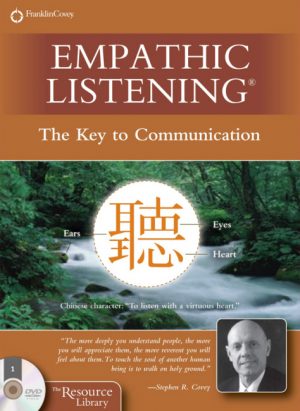
#Empathic listening professional#
Here are some benefits of becoming an empathic listener: Better professional relationships There are many benefits of using empathy when building professional relationships in the workplace, for example, with colleagues.
#Empathic listening how to#
Related: How to improve your active listening skills The importance of empathic listening For this reason, this type of listening is also known as active listening or reflective listening. It also makes it easier for you to find any similarities between their experience and your own, which you can use to show them support and encouragement. This is because it enables you to make an emotional connection with them. It's a listening and questioning method that allows you to easier relate to other people's viewpoints, feelings and emotions. What is empathic listening?Įmpathic listening is the ability to be attentive and responsive to others' input during conversations. In this article, we discuss what empathic listening is, explore its importance, share qualities of an empathic listener and show you five ways in which you can become a more empathic listener. Learning about the importance of empathy can help you become a better listener. Validating others' viewpoints and expressing your compassion is an important way of communicating for building and maintaining strong working relationships. To learn more about how to help those around you who live with mental illness or a substance use disorder, find a Mental Health First Aid course near you.Being a close and caring listener can be as important in the workplace as it is in your personal life. Although you might fear making someone uncomfortable, remember that many people experiencing mental health symptoms want someone to notice them and offer support.

Remember, the person in front of you shares your human condition – with all its needs, struggles and desires. By showing empathy, you can help the person in front of you calm down. Our distress increases when we feel isolated. Stay close enough to the person to show you care, but do not touch the person without asking first. Give the person in front of you enough time to express themselves.

Distress often increases the speed of our speech and gestures. Focus on conveying empathy and not on changing the person or their perspective.Here are some ways to show empathy the next time you encounter someone who may be experiencing a mental health crisis: It also makes it easier for the other person to feel they can talk freely without being judged. Listening empathetically allows the listener to really hear and understand what is being said. This simple gesture validates the other person’s experience. Listening quietly, without engaging in problem-solving, signals that you are on that person’s side. The first way to diffuse a tense situation is to establish rapport with the person in distress. “Most people experiencing distressing emotions and thoughts want an empathetic listener before being offered helpful options and resources.” Instead, it requires taking a moment to step outside of our normal patterns of thinking and feeling to imagine what it feels like to be the person in front of us.

For a person experiencing a mental health problem, having an empathetic listener can be calming and reassuring – even healing.Įmpathy, unlike sympathy, does not mean we agree with the other person or see things from the same point of view. Checking information during a conversation helps ensure patients receive the correct treatments and medications.īut for situations when someone is experiencing symptoms of a mental health crisis, there is another kind of listening that can be more effective: empathetic listening. For people in roles like a nurse or doctor, engaging and responding while listening is an ideal strategy.

We hear a lot about active listening – listening and responding to another person to improve mutual understanding. Many of us forget that we all possess one of the most effective tools to aid someone experiencing a mental health crisis. By Mental Health First Aid USA on July 28, 2017


 0 kommentar(er)
0 kommentar(er)
